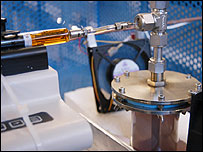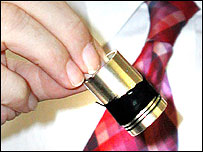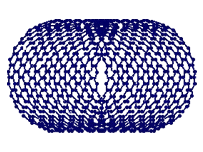July 08, 2004
Nanotubes again
The Beeb has another story (full text here or below) related to our past discussions re: tethered satellites and space elevators. The illustrations are pretty interesting, from a lay perspective:



Nano-team spins tomorrow's yarn
By Jo Twist
BBC News Online science and technology staff
A method to continuously spin a wonder material, which is worth more per kg than gold, has been developed by Cambridge-MIT Institute scientists.
Discovered in 1991, carbon nanotubes are just a few billionths of a metre across, but are ultra-strong.
They have been spun before, but directly spinning them into a fibre as they are made has proven very difficult.
The Cambridge way brings the industrial production of a myriad of materials made of carbon nanotubes a step closer.
The technique has been developed in the last six months by a UK team led by Professor Alan Windle at the Cambridge-MIT Institute (CMI).
"Carbon nanotubes are very, very interesting structures with quite amazing potential. They represent one aspect of nanotechnology," he told BBC News Online.
"Now, suddenly, one can relate this thing called a nanotube into something people can see."
The spinning process happens in furnace equipment which has been specially built at Cambridge University's Department of Materials Science and Metallurgy.
"We wanted to organise the nanotubes in parallel to make a fibre," explained Professor Windle.
"So we came up with a process that makes fibre continuously from a reaction zone."
In very simple terms, the process is rather reminiscent of a candy floss machine, in which a black fluffy cloud is created then spun on to a spindle as a thread.
The nanotubes are created rapidly by squirting a carbon source, like ethanol, and an iron nanocatalyst through a hydrogen carrier, and into a furnace at 1,200 degrees Celsius.
A fine black "elastic smoke", called an aerogel, then forms using the iron in ferrocene as a catalyst, and starts to stick to the cooler wall in the furnace to form fibres.
A spindle then winds the aerogel fibres into a thread, at several centimetres per second.
The result is an extremely fine and strange black thread that is about as strong as clothes fibre, and can carry an electrical current.
Professor Windle and his team aim to improve that strength 10-fold in the next year or so, but they need to learn more about how to organise the nanotubes before strength can be improved.
The problem with nanotubes is that they have been tricky to organise; and to harness their potential use on a large scale, cheap and quick ways of processing them are required.
Nanotube fibres in the form of ribbons were processed by a French team from the Paul Pascal Research Centre, at the University of Bordeaux, in 2000.
But, said Professor Windle, pervious efforts at turning nanotubes into continuous fibres could only be done after they were made, through post-processing methods.
His method means they are made and spun in the same process.
Carbon nanotubes are essentially sheets of graphite, an atom deep, which have folded back on themselves.
They were discovered soon after a spherical cage of carbon atoms, called a buckminsterfullerene - nicknamed a buckyball - was found.
Their discovery excited scientists all over the world because nanotubes are very rigid structures which are as stiff as diamonds along their axes.
They could potentially prove to be stronger than steel.
Space enthusiasts are keen to monitor developments in nanotube technology too because many see them as a way of making viable "space elevator" and tethered satellite technologies.
In theory, Professor Windle explained, a satellite could be "tied" to Earth with a cable, but it has to be light and very strong, hence the excitement around carbon nanotubes.
"If one can make a fibre that strong and that stiff, it would have a myriad of uses," explained Professor Windle.
"It is potentially a strong, cheap, light fibre which will very much enable materials."
Composite materials could be produced containing a high percentage of the fibre, which could be used to coat other materials or surfaces.
This could be very useful in areas of space, molecular electronics, motorcar, and military industries.
Carbon nanotubes could become a key part of creating memory for quantum computers, for instance. Or their commercial success could lie in the less hi-tech industries, said Professor Windle.
The fibres could be woven into strong, light, flexible and conductive textiles. But there is still a long way to go until real use is made of them.
"We have 10 years of very exciting material science here," he said. "But as with so many things, we have done the technology first, and now we have see what happens with it."
Posted by thinkum at July 8, 2004 09:29 PMThe "Carbon Isles" just doesn't have the same ring as "Silicon Valley". If this research works out, someone will have to come up with a better nickname. :) What they're doing sounds a little clumsy, but certainly no worse than the early days of semiconductors.
Silicon has started to stagnate a bit. It's good to have a whole new area to explore.
Posted by: PyeCat at July 9, 2004 01:16 PMIt's, like, totally TUBULAR, man!
(Sorry, it just had to be said. *g*)
It sounded from the article like the material they've produced so far isn't that strong - is that how you read it?
Posted by: Thinky at July 9, 2004 02:32 PMI read the article as saying the material is reasonably strong for its size, but that the size isn't large. I think they're hoping to increase the size and the strength.
For comparison, a strand of metal -- the only available conductor with reasonable loss today -- is very fragile if thin as a thread. It's certainly not as strong as, say, cotton.
Posted by: PyeCat at July 10, 2004 01:59 PMWow. I had no idea that an organic material would compare like that.
But now I'm confused again. Isn't the definition of a nanotube, in part, that its walls are only an atom thick? Or, do you just mean that they hope to find new ways to spin them into rope and cable?
Posted by: Thinky at July 10, 2004 02:59 PMOne nanotube has walls that are only one atom thick. The goal of spinning the thread is to get many nanotubes lined up together. If they are well-organized, the immense strength of a single tiny nanotube is scaled up to a macro scale.
I think the article is saying that the nanotubes are lining up a little, but not as much as the scientists hope.
Posted by: PyeCat at July 11, 2004 12:42 AM